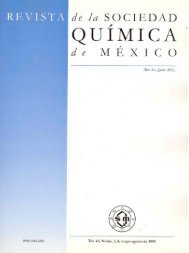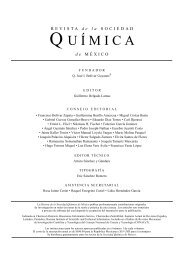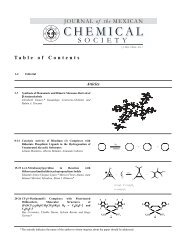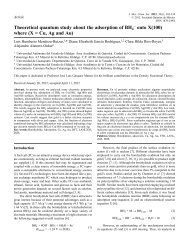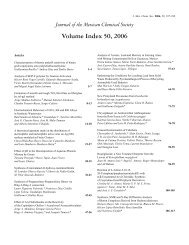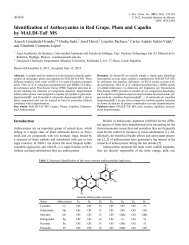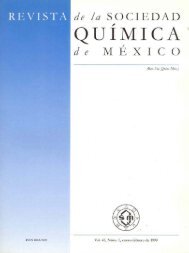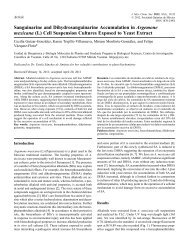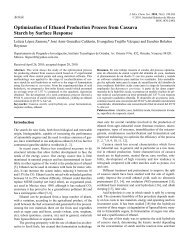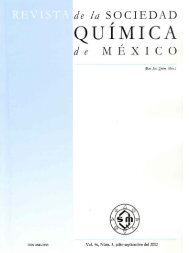SMQ-V047 N-002_ligas_size.pdf - Journal of the Mexican Chemical ...
SMQ-V047 N-002_ligas_size.pdf - Journal of the Mexican Chemical ...
SMQ-V047 N-002_ligas_size.pdf - Journal of the Mexican Chemical ...
You also want an ePaper? Increase the reach of your titles
YUMPU automatically turns print PDFs into web optimized ePapers that Google loves.
New Eremophilanoids from <strong>the</strong> Roots <strong>of</strong> Psacalium radulifolium. Hypoglycemic, antihyperglycemic and anti-oxidant evaluations 161<br />
charose. The anti-oxidant activity <strong>of</strong> some isolated compounds<br />
is also reported.<br />
Results and discussion<br />
Compound (12) was isolated as a yellow solid, and its<br />
HREIMS established <strong>the</strong> molecular formula C 15 H 14 O 4 . UV<br />
spectrum showed bands <strong>of</strong> a conjugated ketone at lmax 336,<br />
277, 245, and 207 nm, and <strong>the</strong> IR spectrum revealed <strong>the</strong> presence<br />
<strong>of</strong> hydroxyl group (3583 cm –1 ), conjugated carbonyl<br />
(1664 cm –1 ) and multiple carbon-carbon bonds (1585, 1463<br />
cm –1 ). The 1 H NMR spectrum (Table 1) showed considerable<br />
similarity with that <strong>of</strong> radulifolin C (7), a compound previously<br />
isolated from this species [14], establishing a close structural<br />
relationship. The most significant difference was <strong>the</strong><br />
downfield shift and multiplicity <strong>of</strong> H-14 (δ 1.85), which<br />
appeared as a singlet, in comparison with <strong>the</strong> chemical shift <strong>of</strong><br />
<strong>the</strong> same protons <strong>of</strong> radulifolin C (δ 1.43), which resonated as<br />
a doublet, indicating <strong>the</strong> presence <strong>of</strong> a hydroxyl at C-6 in 12,<br />
in agreement with <strong>the</strong> molecular formula. 13 C NMR data<br />
showed <strong>the</strong> expected chemical shifts, and <strong>the</strong> assignments<br />
were corroborated by HMQC and HMBC experiments.<br />
Therefore this substance was 6-hydroxy-radulifolin C, and<br />
named radulifolin D (12). The 3-O-methyl derivative <strong>of</strong> 12<br />
has been characterized from a chemical analysis <strong>of</strong> Cacalia<br />
hastata L. var. tanakae [15], but it was considered as an artifact<br />
due to <strong>the</strong> lack <strong>of</strong> optical activity. Radulifolin D (12) is<br />
dextrorotatory, while radulifolin C (7) is levorotatory.<br />
Considering that <strong>the</strong> twisting <strong>of</strong> <strong>the</strong> A/C rings is in <strong>the</strong> opposite<br />
direction to <strong>the</strong> pseudo-axial methyl group at C-6 (to<br />
avoid interactions with <strong>the</strong> methyls at C-13 and C-15), <strong>the</strong><br />
hydroxyl group at C-6 <strong>of</strong> radulifolin D could be tentatively<br />
proposed with <strong>the</strong> β- configuration (12), to explain <strong>the</strong> opposite<br />
specific rotation to that observed for radulifolin C (7).<br />
Radulifolin E (13) was isolated as a UV active solid (λ max<br />
320, 280, 257 nm), with a molecular formula C 17 H 18 O 5 established<br />
from EIMS and NMR data. The IR spectrum contained<br />
bands at 1740 and 1668 cm –1 consistent with <strong>the</strong> presence<br />
<strong>of</strong> an acetate and an α,β-unsaturated ketone, respectively.<br />
The 13 C NMR spectrum (Table 2) showed 17 signals (four<br />
methyls, one methylene, four methines and eight quaternary<br />
carbons, including three carbonyls), and <strong>the</strong> chemical shifts<br />
and multiplicity observed in <strong>the</strong> 1 H NMR spectrum (Table 1)<br />
could be accounted by <strong>the</strong> furanoeremophilane skeleton with<br />
an acetate at C-6 similar to that <strong>of</strong> decompostin (10). The<br />
major difference between radulifolin E (13) and decompostin<br />
was <strong>the</strong> downfield chemical shift for H-1, due to <strong>the</strong> presence<br />
<strong>of</strong> a ketone at C-2. Therefore, radulifolin E (13) was established<br />
as 2-ketodecompostin, previously obtained as a derivative<br />
<strong>of</strong> decompostin via bromination (NBS) and oxidation<br />
(AgNO 3 ) [6d]. 1 H and 13 C NMR assignments (Tables 1 and 2)<br />
were confirmed by HMQC and HMBC experiments.<br />
The FABMS, 1 H and 13 C NMR data for compounds 14<br />
and 15 were consistent with <strong>the</strong> molecular formula C 21 H 28 O 9 .<br />
An intense IR band at ca. 3400 cm –1 for both compounds suggested<br />
<strong>the</strong> presence <strong>of</strong> several hydroxyl groups, and bands at<br />
ca. 1660 cm –1 were ascribed to α,β-unsaturated carbonyl<br />
groups. 1 H and 13 C NMR spectra (Tables 1 and 2) indicated <strong>the</strong><br />
presence <strong>of</strong> a β-D-glucopyranose fragment and a cacalone<br />
aglycon. The anomeric hydrogen <strong>of</strong> 14 was observed at δ 4.42<br />
and <strong>the</strong> analysis <strong>of</strong> <strong>the</strong> COSY spectrum determined <strong>the</strong> sequen-<br />
OH<br />
1<br />
4<br />
15 14<br />
O<br />
12<br />
13<br />
O<br />
R 1 R 2<br />
O<br />
OH<br />
OH<br />
R 1<br />
R 2<br />
O O<br />
1 Cacalol<br />
R 1 R 2<br />
2 CH 3 OH Cacalone<br />
3 OH CH 3 Epi-cacalone<br />
R 1 R 2<br />
4 CH 3 OH Radulifolin A<br />
5 OH CH 3 Epi-radulifolin A<br />
OCH 3<br />
O<br />
OH<br />
O<br />
HO<br />
O<br />
O<br />
O<br />
OCH 3<br />
OH<br />
O<br />
OH<br />
O<br />
R 1 R 2<br />
O<br />
O<br />
R<br />
10 Ac Decompostin<br />
11 Ang Neoadenostylone<br />
6 Radulifolin B<br />
R 1 R 2<br />
7 CH 3 H Radulifolin C<br />
12 OH CH 3 Radulifolin D<br />
8 O-Methyl-1,2-<br />
dehydrocacalol<br />
9 Adenostin<br />
OAc




